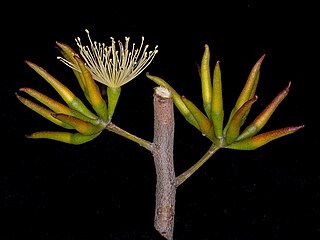
Eucalyptus abdita is a species of mallee with smooth grey bark and cone-shaped to barrel-shaped fuit, that is native to disjunct areas to the north and north-east of Perth, Western Australia.
Eucalyptus dolorosa, commonly known as the Mount Misery mallee or Dandaragan mallee, is a species of eucalypt that is endemic to Western Australia. It is a mallee with a short skirt of rough flaky bark at the base of the trunk, smooth pale greyish brown above, lance-shaped to curved adult leaves, flower buds in groups of seven, white flowers and cup-shaped to spherical fruit.
Eucalyptus angularis, commonly known as Lesueur phantom mallee, is a rare species of mallee that is endemic to the south-west of Western Australia. It has rough bark at the base of the stems, smooth greyish bark above, lance-shaped adult leaves and flower buds in groups of about eleven, but the characteristics of the flowers and fruit have not been recorded.

Eucalyptus arachnaea, commonly known as the black-stemmed mallee, is a mallee or tree that is endemic to Western Australia. It has rough, stringy bark, lance-shaped leaves and white flowers in groups of up to thirteen.
Eucalyptus crispata, commonly known as the Yandanooka mallee, is a species of tall mallee that is endemic to a small area on the east coast of Western Australia. It has a stocking of rough bark near the base of its trunk, smooth grey bark above, lance-shaped adult leaves, flower buds in groups of between nine and eleven, whitish to yellowish cream flowers and cup-shaped, barrel-shaped or hemispherical to cylindrical fruit.

Eucalyptus effusa, commonly known as rough-barked gimlet, is a species of mallee or small tree that is endemic to Western Australia. It has thin, rough bark on the base of the trunk, smooth bark above, linear to narrow lance-shaped adult leaves, flower buds arranged in groups of seven, white flowers and cup-shaped to conical fruit.
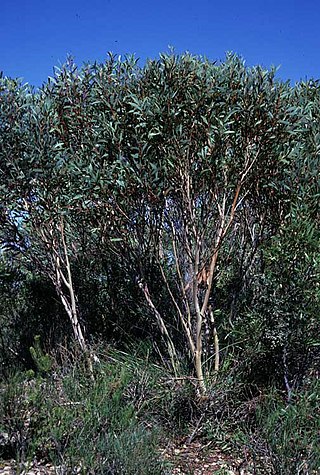
Eucalyptus erectifolia, commonly known as Stirling Range mallee, is a species of mallee that is endemic to Western Australia. It has smooth bark, narrow lance-shaped adult leaves, flower buds in groups of between seven and thirteen, white flowers and cup-shaped fruit.

Eucalyptus exilis, commonly known as Boyagin mallee, is a species of mallee that is endemic to Western Australia. It has thin stems with smooth bark, lance-shaped adult leaves, flower buds in groups of eleven, white flowers and barrel-shaped to shortened spherical fruit.

Eucalyptus gittinsii, commonly known as northern sandplain mallee, is a species of mallee that is endemic to Western Australia. It has smooth greyish bark, sometimes with rough flaky bark near the base, lance-shaped to curved adult leaves, flower buds in groups of three, whitish flowers and cylindrical to barrel-shaped fruit.
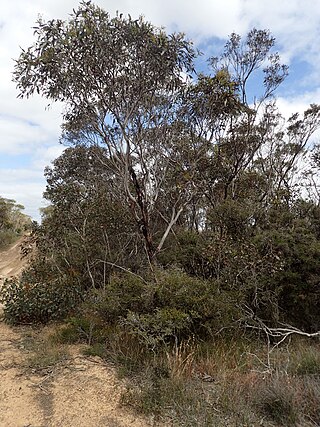
Eucalyptus hebetifolia is a species of mallee that is endemic to southern Western Australia. It has smooth grey and brownish bark with loose ribbons of bark near the base, lance-shaped adult leaves, flower buds in groups of up to thirteen, creamy white flowers and conical to barrel-shaped fruit.
Eucalyptus histophylla is a species of mallee or small tree that is endemic to southern Western Australia. It has smooth bark, often with ribbons of shed bark, linear to narrow lance-shaped adult leaves, flower buds arranged in groups in leaf axils, white flowers and cylindrical to barrel-shaped or conical fruit.
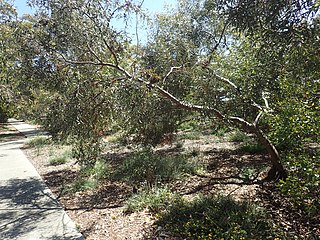
Eucalyptus incerata, commonly known as Mount Day mallee, is a species of mallee that is endemic to southern Western Australia. It has smooth bark, lance-shaped adult leaves, flower buds with a long, horn-shaped operculum and arranged in groups of seven, yellow flowers and barrel-shaped to cup-shaped fruit.
Eucalyptus leprophloia, commonly known as scaly butt mallee, is a species of mallee that is endemic to a small area in Western Australia. It has rough, fibrous bark on the base of the trunk, smooth bark above, lance-shaped adult leaves, flower buds in groups of seven to eleven, white flowers and cup-shaped to barrel-shaped fruit.

Eucalyptus pluricaulis, commonly known as the purple-leaved mallee, is a species of mallee that is endemic to Western Australia. It has smooth bark, dull bluish green, lance-shaped leaves, flower buds in groups of between nine and fifteen, pale yellow flowers and cylindrical to barrel-shaped fruit.

Eucalyptus sporadica, commonly known as the Burngup mallee, is a species of mallee that is endemic to the southwest of Western Australia. It has smooth bark, lance-shaped adult leaves, flower buds in groups of seven, yellowish flowers and down-turned, conical to cylindrical fruit.

Eucalyptus suberea, commonly known as Mount Lesueur mallee or cork mallee, is a species of mallee or a small tree that is endemic to a small area on the west coast of Western Australia. It has rough bark on some or all of the trunk, smooth white bark above, lance-shaped adult leaves, flower buds in groups of eleven to twenty or more, white flowers and shortened spherical fruit.
Eucalyptus thamnoides, also known as brown mallee, is a species of mallee that is endemic to south western Western Australia. It has smooth bark, lance-shaped adult leaves, flower buds in groups of seven, cream-coloured to pale yellow flowers and cup-shaped, conical or bell-shaped fruit.
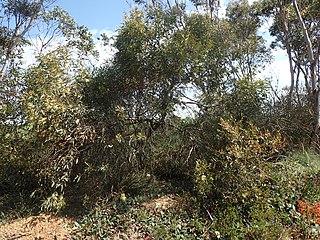
Eucalyptus varia is a species of mallee that is endemic to an area near the south coast of Western Australia. It has smooth bark, narrow lance-shaped adult leaves, flower buds in groups of nine or eleven, yellow flowers and barrel-shaped to cylindrical fruit.
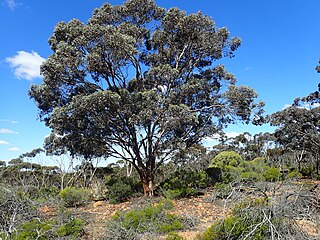
Eucalyptus densa is a species of mallee or mallet that is endemic to Western Australia. It has smooth greyish bark that is shed in curly strips, linear to narrow lance-shaped adult leaves, long, spindle-shaped flower buds in groups of seven or nine, pale yellow or lemon-coloured flowers and conical, cylindrical or barrel-shaped fruit.

Eucalyptus diminuta, commonly known as the spring mallee, is a species of mallee that is endemic to south-west of Western Australia. It has smooth, silvery to greyish bark, sometimes with rough flaky bark near the base, lance-shaped adult leaves, pendulous, elongated flower buds arranged in groups of seven, creamy white flowers and cup-shaped to bell-shaped fruit.

















